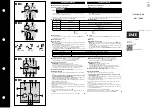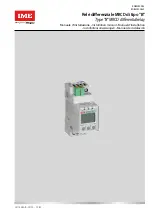
- 42 -
CABLING MATERIAL
Cabling material selection is important for all protection systems. The principles listed below are to be
paid heed to build a robust system.
Cabling with thin & multi-wire cables:
o
Never make a connection without applying ferrules to wire ends!
o
Use 18 mm wire end ferrules for all terminals no’s 1-32. Using ferrules longer than 18
mm may reduce the dielectric withstand capability of the wiring of these terminals!
o
Use 8 mm wire end ferrules for all terminals no’s 34-53. Using ferrules longer than 8
mm may reduce the dielectric withstand capability of the wiring of these terminals!
o
Provide solid earthing with low earth resistance to the relay. Use ring cable
connectors for connections to relay earthing bolts. Make the earthing connection
directly to earth. Never earth the device indirectly or over high resistances!
WARNING!
Solid earthing is one of the fundamental precautions to provide minimum safety
requirements. Before commissioning any electrical system, make sure that earthing
process is done correctly according to the relevant standards!
o
Use appropriate tools for crimping the ferrules. Preferably use crimping tools with
trapeze cross-section crimping type.
o
Use appropriate tools for stripping the cables. Preferably use stripping tools with
adjustable stripping lengths. Apply the instructions of the ferrule manufacturer when
stripping.
o
Use appropriate tools for removing the outer coat of multi-core cables, if applicable.
Preferably use blades with adjustable cutting depths. Apply the instructions of the
cable manufacturer.
o
Use torque screwdrivers to tighten the terminal bolts. Apply (0.56 – 0.69) N·m torque
to the bolts – torque application lower than 0.69 N·m may lead to open circuits or
high contact resistances, while excessive torque application may damage the
terminals!
o
Use non-flammable, standards compliant cables.
o
Determine the wire cross-sections according to relevant standards and engineering
guides.
Cabling with single wire cables is not recommended for protection systems. Mechanical aging
risks, increasing contact resistance over time, and poor flexibility are the most important
negativities of single wire cables. If cabling with single wire cables is essential, check all
connections with great care and apply routine checking procedures to prevent failures. □
Содержание CPM 310 G
Страница 1: ...CPM 310 G Digital Overcurrent Protection Relay User Application Manual vEN 2016 03...
Страница 2: ...2...
Страница 6: ...6 ABOUT DEMA...
Страница 11: ...11 INTRODUCTION...
Страница 32: ...32 PACKING LABELING INFORMATION...
Страница 34: ...34 OPERATING MANUAL...
Страница 53: ...53 RELAY MENUS MANUAL...
Страница 55: ...55 The Menu Tree...
Страница 56: ...56...
Страница 57: ...57...
Страница 58: ...58...
Страница 59: ...59...
Страница 60: ...60...
Страница 61: ...61...
Страница 128: ...128 DIGICONNECT PC PROGRAM MANUAL...
Страница 189: ...189 APPLICATION DIAGRAMS...
Страница 191: ...191 Sample Power Transformer Protection Application Diagram...
Страница 193: ...193 FUNDAMENTAL CABLING DIAGRAM...
Страница 195: ...195 APPLICATION DIAGRAM NO 2 Function Function Activation Address Output Settings Internal Error Alarm Automatic...
Страница 203: ...203 APPLICATION DIAGRAM NO 10 RS485 Cabling...
Страница 204: ...204 TECHNICAL DATA...
Страница 220: ...220 GLOSSARY...
















































